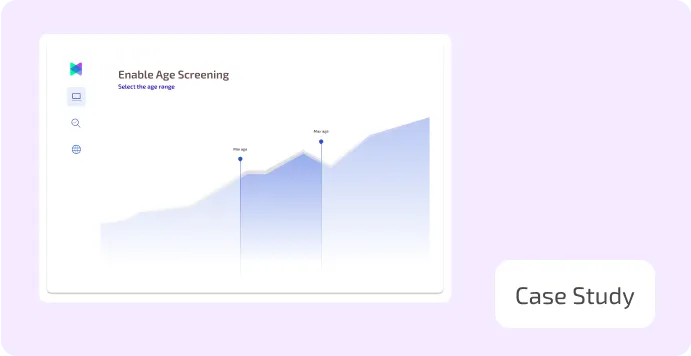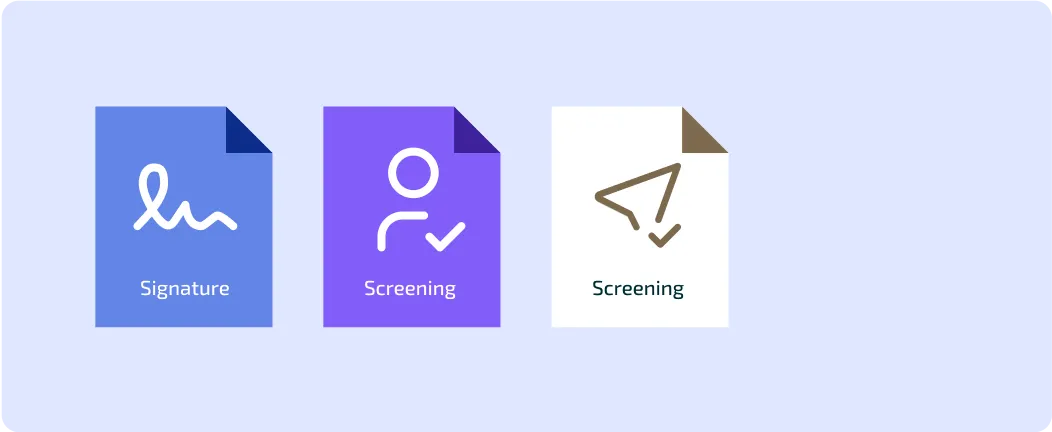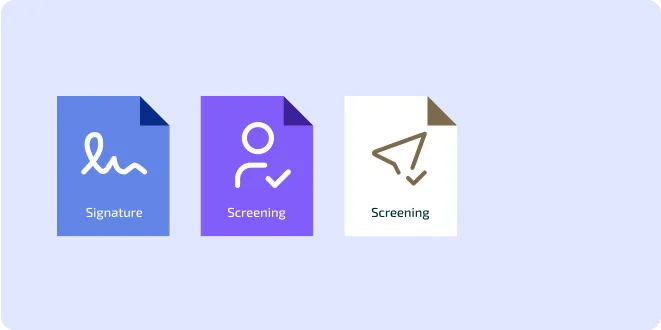.webp)
Published on
April 15, 2025
16 Banking Technology Trends to Check Out in 2025
In this story

Accelerate AML Compliance: Meet Regulatory Demands with 80% Less Setup Time
.svg)
.svg)
The banking industry is undergoing a profound transformation driven by rapid advancements in banking technology.
This article explores the critical role of banking technology in modern banking, highlighting why banks must adopt technological innovations. It covers the importance of advanced data frameworks, the pressures of increased regulation, the shift towards cloud adoption and infrastructure modernization, and the growth of open banking, all while addressing the rising concerns around cybersecurity.
The Role of Banking Technology in Modern Banking
Banking technology has become the backbone of contemporary banking operations, enabling institutions to enhance efficiency, offer innovative services, and improve customer experiences.
Emerging technologies in banking are transforming customer interactions, with AI-driven chatbots and virtual assistants providing seamless, 24/7 support.
Key areas where banking technology is making a significant impact include:
- Enhanced Customer Experience: Digital platforms and mobile applications provide customers with seamless access to banking services, allowing for real-time transactions and personalized financial management.
- Operational Efficiency: Automation of routine tasks through technologies like Robotic Process Automation (RPA) reduces operational costs and minimizes human errors, leading to more streamlined processes.
- Data-Driven Decision Making: Emerging technologies in the financial services industry are revolutionizing risk management, enabling real-time fraud detection and predictive analytics for better decision-making.
How Are Banks Using AI?
Banks are increasingly integrating AI across various operations to optimize processes and deliver better services. Key applications include:
- AI-Powered Fraud Detection and Anti-Money Laundering (AML) Compliance: AI algorithms analyze transaction patterns to identify anomalies indicative of fraudulent activities or money laundering, enabling proactive measures to protect assets and ensure regulatory compliance.
- Predictive Analytics for Risk Profiling: By leveraging machine learning, banks can assess vast datasets to predict potential risks associated with loans and investments, facilitating more informed decision-making and effective risk management strategies.
- AI-Driven Automation in Back-Office Operations: Automation of routine tasks such as data entry and processing enhances operational efficiency, reduces errors, and allows staff to focus on more strategic activities.
Does AI Eliminate Risks or Create New Ones?
While AI, one of the latest banking technology trends in financial services, offers significant benefits, it also introduces new risks that banks must address.
On the one hand, AI enhances risk management capabilities by automating processes, improving decision-making accuracy, and enabling real-time fraud detection. For instance, AI-driven systems can analyze vast datasets to identify unusual transaction patterns, thereby strengthening anti-money laundering efforts.
However, the integration of AI also presents novel challenges. These include:
- Data Privacy and Security: The extensive use of AI necessitates access to large volumes of sensitive data, raising concerns about data breaches and unauthorized access.
- Operational Risks: Dependence on AI systems can lead to vulnerabilities, including system failures and susceptibility to malicious attacks, potentially disrupting banking operations.
- Regulatory Compliance: Ensuring that AI applications comply with evolving regulations requires continuous oversight and adaptation to avoid legal and financial repercussions.
Comply quickly with local/global regulations with 80% less setup time
.svg)
.svg)
16 Key Technologies Banks Need to Stay Competitive in 2025
To remain competitive in 2025, banks must adopt a suite of advanced banking technologies that enhance efficiency, security, and customer satisfaction. Below is a brief overview of key banking technologies and their benefits:
1. AI and Machine Learning in Fraud Detection & AML Compliance
These banking technologies analyze transaction patterns to detect and prevent fraudulent activities, strengthening anti-money laundering efforts.
2. Chatbots and AI Assistants for Customer Service
Bank technology trends in financial services are reshaping how financial institutions deliver services, creating more efficient and personalized customer experiences. AI-driven chatbots provide 24/7 customer support, resolving common inquiries swiftly and enhancing customer engagement.
3. Generative AI in Financial Planning and Advisory Services
Generative AI, one of the latest banking technology trends, creates personalized financial plans and investment strategies, offering tailored advice to clients.
4. Super-Apps and Next-Gen Digital Banking Services
Super-apps integrate multiple services into a single platform, offering seamless digital banking experiences and fostering customer loyalty.
A recent Morning Consult survey for the American Bankers Association reveals that more than half of U.S. consumers (55%) now prefer mobile apps for banking, marking the highest usage rate since the survey began in 2017.
5. AI Regulation, Oversight, and Transparency
Implementing AI governance ensures ethical use, compliance with regulations, and builds trust with customers.
6. Cloud Computing for Scalable and Secure Banking
Cloud solutions offer scalable infrastructure, enabling banks to manage resources efficiently and enhance data security.
7. Data Fabric for Unified Data Management & Insights
A data fabric architecture unifies disparate data sources, providing comprehensive insights and supporting informed decision-making.
8. Process Automation & Robotic Process Automation (RPA)
RPA automates repetitive tasks, reducing errors and operational costs and allowing staff to focus on strategic activities.
9. Blockchain Technology in Banking
Blockchain banking technology is a new technology in banking industry that ensures secure, transparent transactions, reducing fraud and enhancing trust in financial operations.
As blockchain, AI, and automation take center stage, emerging technologies in financial services industry are reducing operational costs while enhancing transparency and trust between institutions and their customers.
10. Big Data and Advanced Analytics in Financial Services
Leveraging big data enables predictive analytics, enhancing risk assessment and personalized product offerings.
"By applying big data analytics, banks can evaluate risk in real time using near-continuous analysis of large data sets from various sources, such as transactions, customer behavior, and market conditions. This allows banks to identify possible compliance risks at the right time to make sure early actions can be taken to prevent them." - Kinil Doshi is a senior VP at Citibank
11. Cybersecurity & Fraud Prevention Strategies
Advanced cybersecurity measures protect against evolving threats, safeguarding customer data and maintaining trust.
12. Internet of Things (IoT) in Banking
IoT devices provide real-time data, enhancing services like asset tracking and personalized customer experiences.
13. Biometric Authentication & Digital Identity Verification
New banking technology innovations like biometric authentication and digital identity verification are not just about improving operations; they’re fundamentally changing how banks interact with clients, offering greater convenience and accessibility. Biometric systems, a new technology in banking industry, offer secure, convenient authentication methods, reducing fraud and enhancing user experience.
14. RegTech and Innovations in Regulatory Compliance
RegTech solutions automate compliance processes, reducing costs and ensuring adherence to regulations.
15. Open Banking and API-Driven Ecosystems
Open banking, one of the new banking technology innovations, facilitates data sharing through APIs, fostering innovation and offering customers more personalized services.
16. Payment Processing Innovations and Real-Time Transactions
Innovations in payment processing enable real-time transactions, enhancing customer satisfaction and operational efficiency.
Tackling Challenges in Banking Tech Transformation
The impact of bank technology trends extends beyond operational improvements, driving cultural shifts within financial organizations toward a more agile and tech-savvy workforce. However, implementing advanced banking technology can present some challenges in selecting and integrating these technologies.
1. Regulatory and Compliance Risks
Financial institutions operate within a stringent regulatory framework that mandates adherence to various laws and standards. Integrating new technology in financial services must align with these regulations to avoid legal repercussions and maintain customer trust.
2. Integration Complexities with Legacy Systems
Many banks rely on legacy systems that are deeply embedded in their operations. Integrating modern technologies with these outdated systems can be technically challenging and resource-intensive. Issues such as compatibility problems, data synchronization difficulties, and system downtime during integration can disrupt services and affect customer satisfaction. Additionally, failing to manage these integration risks can lead to budget overruns and project delays. Proper planning and risk management are essential to mitigate these challenges.
3. Cybersecurity Threats and Data Privacy Regulations
As banks adopt advanced technologies, the volume of sensitive data processed increases, heightening the risk of cyber threats. Ensuring strong cybersecurity measures and compliance with data privacy regulations is paramount to protect against data breaches and maintain customer trust.
4. Cost and ROI Considerations for New Tech Adoption
Adopting new technology in financial services involves significant financial investment, including costs for software, hardware, training, and ongoing maintenance. Evaluating the return on investment (ROI) is essential to ensure that the benefits, such as increased efficiency and revenue growth, justify the expenditures.
Financial institutions must conduct thorough cost-benefit analyses and consider both short-term expenses and long-term gains when planning banking technology investments.
5. Balancing Automation with Human Oversight
While automation enhances efficiency, maintaining appropriate human oversight is crucial to address complex situations that require human judgment. Striking the right balance ensures that automated systems operate effectively while allowing human intervention when necessary.
Over-reliance on automation without adequate oversight can lead to errors, ethical concerns, and loss of customer trust. Therefore, implementing clear policies and training programs is essential to manage this balance effectively.
6. Data Governance and Quality
Ensuring the accuracy, consistency, and reliability of data is fundamental for effective decision-making and compliance. Poor data governance can lead to erroneous analyses, regulatory non-compliance, and operational inefficiencies. Establishing robust data management frameworks is essential to maintaining data integrity and supporting technological initiatives.
7. Talent Shortages and Skill Gaps
The rapid evolution of banking technology requires professionals with specialized skills in areas such as AI, cybersecurity, and data analytics. Banks may face challenges in recruiting and retaining talent with the necessary expertise, hindering the successful implementation and management of new technologies. Investing in training and development programs can help bridge these skill gaps.
8. Customer Trust and Adoption
Introducing new technologies, especially those involving data sharing and AI, can raise concerns about privacy and security among customers. Building and maintaining customer trust is essential for the adoption of technological solutions. Transparent communication about data usage, robust security measures, and user-friendly interfaces can facilitate customer acceptance and engagement.
9. Change Management and Organizational Culture
Implementing new technologies requires significant changes in processes and workflows, which can encounter resistance from staff accustomed to existing systems. Effective change management strategies, including clear communication, training, and involvement of stakeholders in the transition process, are crucial to overcome resistance and ensure successful adoption.
10. Vendor Management and Third-Party Risks
Collaborating with banking technology vendors introduces risks related to service reliability, data security, and compliance. Conducting thorough due diligence, establishing clear contractual agreements, and maintaining ongoing oversight are essential to managing these third-party risks effectively.
How to Choose the Best Banking Technology for Your Success
A strategic approach involves aligning banking technology with business objectives, assessing security and scalability requirements, carefully selecting vendors, and building a resilient infrastructure.
1. Aligning Technology with Business and Compliance Goals
Integrating banking technology with a bank's strategic objectives and regulatory obligations ensures that technological investments drive business growth while adhering to legal standards. Key steps include:
- Strategic Planning: Develop a comprehensive IT strategy that supports the bank's mission and vision, ensuring that banking technology initiatives contribute to business growth and operational efficiency.
- Regulatory Alignment: Stay abreast of current and forthcoming regulations, incorporating compliance requirements into banking technology solutions to mitigate legal risks.
- Performance Metrics: Establish clear metrics to evaluate the effectiveness of banking technology in achieving business goals and maintaining compliance.
2. Assessing Security, Risk, and Scalability Needs
A thorough assessment of security measures, risk management strategies, and scalability potential is vital to protect sensitive data and accommodate future growth.
- Security Measures: Implement powerful and strong cybersecurity protocols to safeguard against evolving threats, including regular security audits and employee training.
- Risk Management: Develop comprehensive risk assessment frameworks to identify and mitigate potential vulnerabilities associated with new technologies.
- Scalability Planning: Choose technologies that can scale with the bank's growth, ensuring that systems can handle increased transaction volumes and data without compromising performance.
3. Vendor Selection and Third-Party Risk Management
Collaborating with external vendors necessitates diligent evaluation to ensure that third-party services align with the bank's standards and regulatory requirements.
- Due Diligence: Conduct comprehensive assessments of potential vendors' security practices, financial stability, and compliance records.
- Continuous Monitoring: Establish ongoing oversight mechanisms to monitor vendor performance and compliance, addressing any issues promptly.
- Clear Agreements: Define expectations, responsibilities, and compliance requirements in detailed contracts to prevent misunderstandings and ensure accountability.
4. Building a Future-Proof Tech Infrastructure
The adoption of emerging technologies in banking is enabling hyper-personalized financial services. Experts predict that future banking technology trends will focus heavily on biometric authentication, offering a seamless and secure alternative to traditional methods like PINs and passwords.
- Modular Architecture: Design systems with modular components that allow for easy updates and integration of emerging technologies.
- Cloud Solutions: Leverage cloud computing to enhance flexibility, scalability, and disaster recovery capabilities.
- Continuous Innovation: Foster a culture of innovation, encouraging the exploration and adoption of new technologies that can provide competitive advantages.
Automate Banking Processes with the FOCAL Platform
The FOCAL platform is here to make your bank’s operations smoother, safer, and more customer friendly. It offers a range of tools that help you provide better services while staying compliant and protecting against risks.
FOCAL helps with Verification by making it quick and easy to verify customers' identity and income. This speeds up onboarding and ensures everything is secure. The Customer Due Diligence and AML Compliance tools keep you in line with regulations, helping you avoid penalties and risks.
When it comes to protecting your bank and customers, FOCAL’s Fraud Prevention and Transaction Screening tools help you detect suspicious activities in real-time. Customer Screening and Sanction Screening ensure you follow global rules and reducing the risk of financial crimes.
If you'd like to learn more about FOCAL AML Compliance and Fraud Prevention solutions or have specific questions, please schedule a free one-on-one meeting with our experts.
Final Thoughts
The banking sector is evolving rapidly, driven by the latest trends in banking technology that prioritize efficiency, security, and customer experience. As digital banking trends continue to reshape financial services, banks are adopting AI, automation, and blockchain to enhance operations. Also, with the rise of digital currencies and AI-driven solutions, future banking technology trends are poised to offer unprecedented efficiency and accessibility for consumers worldwide.
New technology in the banking industry is also driving major transformations, with cloud computing and open banking redefining traditional business models. Keeping up with banking tech trends is essential for financial institutions to remain competitive and meet rising consumer expectations. Through innovation in banking, institutions can offer faster, safer, and more accessible services. As technology trends in banking continue to evolve, banks are integrating advanced analytics and cybersecurity solutions to strengthen their digital infrastructure.
Understanding banking industry technology trends is now a strategic priority, as fintech collaborations and AI-driven automation shape the future of finance. By embracing financial services technology trends, banks can enhance customer trust, streamline operations, and stay ahead in a rapidly changing landscape.
FAQs
Q1. Which banking technology is used the most in the banking industry today?
In 2025, artificial intelligence (AI) has become the most widely adopted banking technology in the banking sector. Banks are leveraging AI for various applications, including fraud detection and AML compliance. In fact, major financial institutions are investing heavily in AI to enhance operational efficiency and customer experience.
Q2. How can banks stay ahead of rapid technological changes?
To keep pace with rapid technological advancements, banks should focus on the following strategies:
- Continuous Investment in Technology
- Collaboration with FinTechs
- Focus on Cybersecurity
- Agile and Open-Source Platforms
Q3. Will blockchain replace traditional banking systems?
It is unlikely that blockchain banking technology will completely replace traditional banking systems in the near future. Instead, banks are exploring hybrid models that integrate blockchain to improve specific processes, such as cross-border payments and smart contracts, aiming to combine the strengths of both systems.
Streamline Compliance: Achieve 80% Faster Setup for Fraud Prevention
.svg)
.svg)

How Aseel reduced onboarding time by more than 87% using FOCAL
Learn how FOCAL empowered Aseel to achieve new milestones.
.svg)
.svg)
Mastering Fraud Prevention: A Comprehensive Guide for KSA and MENA Businesses
51% of organizations fell victim to fraud in the last two years, don't be caught off guard, act proactively.
.svg)
.svg)
Featured blog posts
.svg)





AI-Driven Precision in Fraud Risk and AML Compliance
.svg)
.svg)

.svg)
.png)






.webp)



.svg)








%20(1).webp)
Comments
Leave a Reply
Comment policy: We love comments and appreciate the time that readers spend to share ideas and give feedback. However, all comments are manually moderated and those deemed to be spam or solely promotional will be deleted.